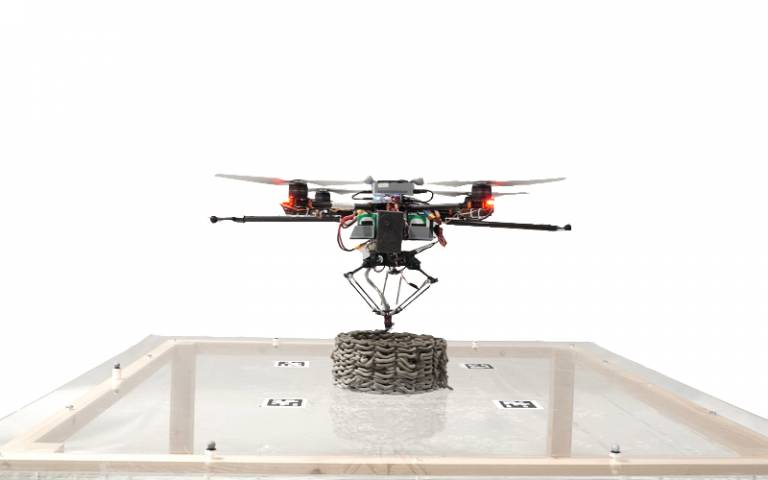A new system of flying drones working together to 3D print material, has been developed by a team involving researchers at UCL and Imperial College London. It's the first time flying drones have been coordinated like this to 3D print an object.

The system, called Aerial Additive Manufacturing (Aerial-AM), is a new approach to 3D printing using collaborative flying robots to transport and deposit building material. Inspired by natural builders like bees and wasps, it employs a fleet of drones collectively working together from a single blueprint.
The multifaceted system consists of several BuilDrones, which deposit building material one layer at a time during flight, as well as quality-controlling ScanDrones, which continually measure the BuilDrones' output and inform their next manufacturing steps.
Unlike traditional 3D printing systems, in-flight 3D printing doesn't require an enclosure or supports for the printing nozzles, allowing for on-site manufacturing and building in difficult-to-access or dangerous locations such as post-disaster relief construction, tall buildings or infrastructure.
Aerial-AM uses both a 3D printing and path-planning framework that enables a team of drones to adapt to variations in the geometry of a structure as manufacturing progresses. Throughout printing, the drones assess already printed geometry in real time and adapt their behaviour to ensure they meet the build specifications and manufacturing tolerances. The drones are fully autonomous in flight, but there is a human controller in the loop who can monitor progress and intervene if necessary.
The study was recently featured on the cover of Nature magazine.
YouTube Widget Placeholderhttps://www.youtube.com/watch?v=pDKNEO0gDuE
Dr Robert Stuart-Smith (UCL Computer Science) and Dr Vijay M. Pawar (UCL Bartlett School of Sustainable Construction), joint directors of UCL's interdisciplinary Autonomous Manufacturing Lab, developed the system's coordination software, known as the multi-agent mission-planning framework, which governs the collective flight. In addition, large scale physical experiments of the multi-robot manufacturing method took place in UCL's state-of-the-art aerial robot testing arena at the Here East innovation and technology complex.
There, the robots built proof-of-concept prints, including a 2.05 metre, 72-layer-tall cylinder out of a polyurethane-based foam material, and an 18 centimetre, 28 layer-tall cylinder from a custom-designed structural cement-like material.
Dr Stuart-Smith (UCL Computer Science) said: "We've demonstrated the first-ever robots that are 3D printing in flight, and it's a pretty amazing achievement. By working with swarms of small robots that can make decisions as they build, tomorrow's architects will be able to change building designs halfway through construction and tailor projects to fit a dynamic environment."
The technology promises to simplify building and repairing structures in hard-to-access locations. The researchers plan to next work with construction companies to further validate and develop the technology, and provide repair and manufacturing capabilities. They believe the technology will provide significant cost savings and reduce access risks compared to traditional manual methods.
Lead author Professor Mirko Kovac (Imperial College London) said: "We've proved the concept that drones can autonomously work in tandem to construct and repair buildings, at least in the lab. This scalable solution could help construction and repair in difficult-to-reach areas."
UCL was part of a consortium of researchers led by Professor Kovac from Imperial and Empa and the Swiss Federal Laboratories of Materials Science and Technology, alongside co-authors at the University of Bath, University of Pennsylvania, Queen Mary University of London, and Technical University of Munich.
This work was funded by the Engineering and Physical Sciences Research Council, part of UKRI. It was launched by Dr Stuart-Smith and Professor Kovac after a pilot research collaboration, and an award for a demonstration on pipeline repair. The project is also supported by Industrial Partners Skanska, Ultimaker, Burohappold, and BRE.






